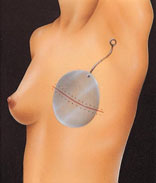If Your Doctor Recommends Tissue Expansion…
Tissue expansion is a relatively straightforward procedure that enables the body to “grow” extra skin for use in reconstructing almost any part of the body. A silicone balloon expander is inserted under the skin near the area to be repaired and then gradually filled with salt water over time, causing the skin to stretch and grow. Although tissue expansion is most commonly used for breast reconstruction, it also may be used to repair skin damaged by birth defects, accidents or surgery, and in certain cosmetic procedures.
If your doctor is recommending tissue expansion, this web page will give you a basic understanding of the procedure. It can’t answer all of your questions, since a lot depends on your individual circumstances. Please be sure to ask your surgeon if there is anything you don’t understand about the procedure.
The Best Candidates for Tissue Expansion
Almost anyone in need of additional skin can benefit from tissue expansion, from infants to elderly men and women.
The procedure is used widely in breast reconstruction when there is not enough skin to accommodate a permanent implant to restore a woman’s natural appearance. It is also an option for repairing or replacing areas of the scalp, where hair growth makes it difficult to replace lost tissue with skin from other areas of the body. Tissue expansion generally produces excellent results when reconstructing some areas of the face and neck, the hands, arms, and legs.
Expansion may be more difficult on the back, torso, or other areas where skin is thick. If the affected area is severely damaged or scarred, expansion is probably not an option, since healthy skin is the first requirement.
Advantages and Disadvantages
Until recently, surgeons were limited to skin flaps and skin grafts to reconstruct damaged tissue. Tissue expansion, however, provides an added technique with several advantages.
First, expansion offers a near-perfect match of color, texture, and hair-bearing qualities. Second, because the skin remains connected to the donor area’s blood and nerve supply, there is a smaller risk that it will die. In addition, because the skin doesn’t have to be moved from one area to another, scars are often less apparent.
On the other hand, skin expansion has one significant drawback: the length of time required to grow additional skin. Depending on the area to be reconstructed, tissue expansion can take as long as 3 – 4 months. During this time, the expander creates what can be an unsightly bulge, which is desirable in breast reconstruction, but can be quite noticeable for someone requiring repair of the scalp or other areas of the body. Furthermore, the procedure requires repeated visits to the surgeon for injection of the salt water that inflates the balloon. For some people, the inconvenience and obvious appearance of an expander are enough for them to consider other options.
All Surgery Carries Some Uncertainty and Risk
Skin expansion can produce some remarkable results. But as with any operation, there are risks associated with surgery and specific complications associated with this procedure.
The most common concern is that the silicone expander used in the procedure will break or leak while it is in the body. While expanders are rigorously tested and placed with care, leaks do occur. If the expander should leak, the salt-water solution, also known as saline, used to fill the expander is harmlessly absorbed by your system and the expander is replaced in a relatively minor surgical procedure.
A small percentage of patients develop an infection around the expander. While this may occur at any time, it’s most often seen within a few weeks after the expander is inserted. In some cases, the expander may need to be removed for several months until the infection clears. A new expander can then be inserted.
You may have concerns about the use of a silicone tissue expander in this procedure because of the Food & Drug Administration’s (FDA) limitations on silicone breast implants. At this time, the FDA ruling does not affect tissue expanders because they are filled with salt water, not silicone gel, and are left in place for only six to 10 weeks, not permanently. Be sure to ask your doctor if you want to know more about the FDA recommendations.
Planning Your Surgery
During your initial consultation, your surgeon will evaluate your condition. Your age, skin condition, medical history and other factors will help your surgeon determine if you’ll benefit from tissue expansion. Your flexibility and tolerance for the inconvenience associated with this procedure will help you determine if you want to pursue it. Before proceeding with tissue expansion, discuss your expectations and your understanding of it with your surgeon.
Preparing For Your Surgery
Your surgeon will give you specific instructions on how to prepare for surgery, including guidelines on eating and drinking, smoking, and taking or avoiding certain medications.
If you smoke, your surgeon will probably ask you to quit for at least two weeks before and after your surgery, since smoking may have an effect on how well you heal.
Whether your surgery is done on an outpatient or inpatient basis, you should arrange for someone to drive you home after your surgery, and to help you out for a day or two, if needed.
Where Your Surgery Will Be Performed
While most tissue expansion is done in an outpatient surgical facility, the size and location of the expansion, as well as the preference of the patient and surgeon, will dictate where the surgery takes place.
Your surgeon may begin tissue expansion immediately at the time of breast removal. If you’ve had an injury, on the other hand, your surgeon will probably recommend that tissue expansion be performed in an outpatient surgical facility after the wound has healed.
More and more frequently, surgeons are performing tissue expansions on an out patient basis for cost savings and convenience.
Types of Anesthesia
Your surgeon may use local anesthesia, combined with a sedative to make you drowsy. You’ll be awake but relaxed, and should feel little discomfort. Or, your surgeon may recommend the use of a general anesthesia, in which case you’ll sleep through the entire operation.
The Surgery
In most cases, the initial operation will take one to two hours, depending on the size and area of skin to be expanded. Your surgeon will begin by making a small incision next to the area of skin to be repaired, and will do everything possible to make the incision as inconspicuous as possible.
He or she will then insert the silicone balloon expander in a pocket created beneath the skin. The expander includes a tiny tube and a self-sealing valve that allows the surgeon to gradually fill the expander with saline solution. The valve is usually left just beneath the surface of the skin.
Once the incision has healed, you’ll be asked to return to your surgeon’s office periodically so that the expander can be injected with additional saline. As the expander enlarges, your skin will stretch. In some people, this procedure causes some minor discomfort.
When the skin has stretched enough to cover the affected area, you’ll have a second operation to remove the expander and reposition the new tissue. In breast reconstruction, the surgery required to remove the expander and insert the permanent implant is relatively brief. More complex surgery to repair skin on the face or scalp will take longer, and may require more than one expansion sequence to complete.
After Your Surgery
How you feel after surgery depends on the extent and complexity of the procedure. The initial surgery to insert the expander causes most patients only temporary discomfort which can be controlled with medication prescribed by your physician.
You may feel some minor discomfort each time saline is injected into the expander, but this usually lasts only an hour or two. The follow-up procedure to remove the expander and put the new tissue in place may create some temporary discomfort, but this, too, can be controlled with medication.
Getting Back to Normal
Again, how soon you resume your normal routine depends on the length, complexity and type of surgery you’ve had. For breast reconstruction patients, if tissue expansion is separate from breast removal, normal activity can resume in two to four days.
Most tissue expansion patients find they can keep up with their normal routine while the expander is in place. Following the second surgery, most patients are up and about within a week.
Your New Look
Generally, the results of tissue expansion are superior to other methods used to reconstruct or repair damaged skin. But keep in mind, the goal is improvement, not perfection. For most tissue expansion patients, the procedure dramatically improves their appearance and quality of life following surgery.
If you’re physically healthy, psychologically stable, and realistic in your expectations, you’ll probably be quite pleased with your results.





